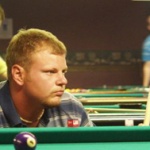For the Record
John Schmidt’s majestic 626-ball run was the culmination of years of single-minded effort and required a dedicated support team and incredible mental fortitude.
Story By Mike Panozzo
For John Schmidt, it was always personal.
At least, it became personal that day 25 years ago when fellow pro Bobby Hunter introduced him to straight pool.
“We were in a poolroom and he was showing me how to play straight pool,” recalled Schmidt. “The first thing I asked was, “What’s the all-time high run?” I’ll never forget it. About nine people in the room all chimed in at the same time, “Willie Mosconi, 526 balls, Springfield, Ohio, 1954.” I knew right then that this was THE record in pool. This was the number EVERYBODY knew.
“Then I looked at all the photos of Mosconi. He was always dressed so dapper. You could tell he was a man respected and revered. I started wondering, “Am I good enough to even get close to a number like that?””
The answer, of course, was yes. On Memorial Day 2019 in Monterey, Calif., Schmidt not only got close, he actually realized the feeling of staring down that very number.
“Once I topped 500,” Schmidt recalled, “and got to the break ball at 504, the panic, nerves, fear, etc., all set in. I don’t know how I didn’t dog it.”
And when ball number 527, the 11 ball, was all that stood between himself and pool immortality, Schmidt found himself overwhelmed by the moment. He paused, put down his cue and excused himself to the men’s room at Easy Street Billiards, the room he all but lived in for 54 days during three extended visits over a 14-month period.
“A bit of a crowd had built up and I was starting to get a little teary-eyed,” Schmidt admitted. “I wasn’t worried about gushing into tears, but I was watering up a bit. I needed to just be by myself for a minute. I splashed some water on my face and gathered myself.”
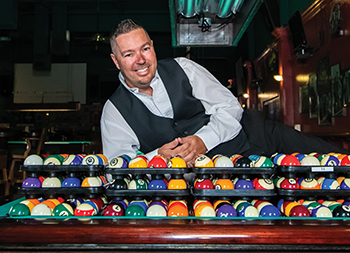
After taking a deep breath, Schmidt marched back to the table, looking anything but Mosconi-esque in a golf shirt, blue shorts (“I wore them every day because they’re so comfortable!”) and Hoka shoes. With his wife Felicity, benefactor and rack caddy Doug Desmond, and California cuemaker Jerry McWorter sitting silently off to the side, Schmidt lined up the shot he had fantasized about over the years. The 11 ball was just six inches from the corner pocket and the cue ball was eight inches behind. The shot was at a slight angle.
“When I first hit it, my heart stopped,” said Schmidt. “I had the whole pocket but I knew I hit it thick. It went in, but it was into the left side of the pocket. I didn’t want to touch a face as it went in.
“I thought to myself, “My god, if I’d missed a hanger at 527 I would have stepped into traffic.””
With the weight of 20-plus years obsessing over Mosconi’s storied mark lifted, Schmidt settled back into a natural groove. He rattled through six more racks before missing on a combination shot. His record-shattering run had reached 626 balls.
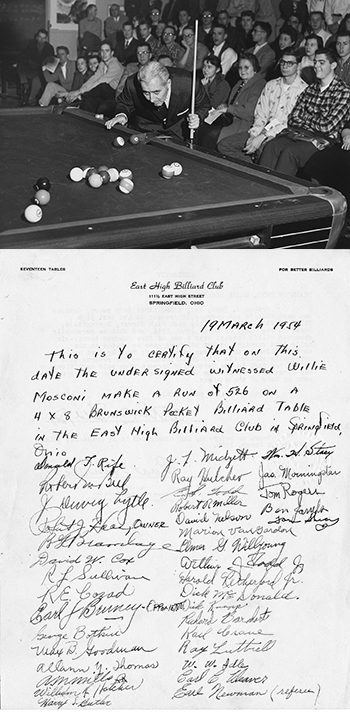
“This number meant so much to me,” Schmidt understated. “I feel like I have been chasing this number my whole life. It was a strange thing.”
Not surprisingly, Schmidt wasn’t really sure how to celebrate the feat. There were no balloons over the table waiting to be released if and when he broke the record. There were no television or newspaper reporters waiting to interview him. There was, in fact, a suddenness to the ending. The long journey was over.
“We just kind of cleaned everything up at the room and went back to the apartment,” Schmidt said.
After cleaning up at their shared apartment in Del Monte Forest along the scenic 17-Mile Drive, the Schmidts, along with Desmond and his wife Cecilia, celebrated at Monterey’s famed Whaling Station Steakhouse, perched above Cannery Row and overlooking Monterey Bay. The hero washed down crab and lobster with several glasses of his favorite cabernet sauvignon.
Having had time to digest the personal magnitude of his accomplishment and reflect on the long road he’d endured, Schmidt shared his thoughts.
“A lot of people think I did this for attention or so people can tell me I’m great,” he started. “I could have been on a deserted island and never met a soul, and I still would have kept trying to top 526. I’ve always been curious about whether I could do it. The skill that’s required to run, say, 250, is so immense that it boggled my mind that [Mosconi] could run 37 racks in a row without hooking himself or missing a ball. It became a personal obsession.
“There are some things that you KNOW you can do, and you’d bet your life on it. I didn’t know if I could do this.”
Not that John Schmidt is a struggling amateur. He has been a top American professional player for more than 20 years. He has won the prestigious U.S. Open 9-Ball Championship, numerous national and regional events, one-pocket titles and, of course, straight pool titles. He has played for Team USA in the Mosconi Cup twice.
But the Holy Grail for the 46-year-old from Hesperia, Calif., has never been a tournament title. It has been, at times, an unhealthy obsession with the number 526.
“This has been a journey of curiosity and self-discovery,” Schmidt acknowledged. “Sure, I love straight pool, but it was more than that. Could I challenge myself like this and hold my nerve together? Did I have the shot-making ability and pattern recognition?
Schmidt never needed an opponent to enjoy playing pool, and straight pool offered the perfect challenge of man vs. himself. The steep odds against him ever reaching 526 never deterred him.
“Just to have a shot after that many consecutive break shots is almost impossible,” Schmidt contended. “On top of that, over all those racks you don’t have a skid or a miscue or a treetop or a roll-off. Plus, you need the skill. Finally, you are shooting knowing that 65 years have gone by since that number happened. That adds pressure because Willie wasn’t shooting at a number. He just kept shooting. I had a specific number that I was chasing.
“Believe me, if anyone understood the odds, it was me.”
Through the years, Schmidt often set days aside to take serious runs at 526. His 400-ball run in Milton, Fla., in 2004 earned him the moniker “Mr. 400” and cemented his reputation as a straight pool big shot. He topped 400 again three years later in Virginia, reaching 403. Only a handful of players had reached that rarified air, including Billiard Congress of America Hall of Famers Earl Strickland (408), Allen Hopkins (421), Ray Martin (426) and Dallas West (429). While legend claimed that New York’s Michael Eufemia had run 625 in the 1970s, the closest recognized run to Mosconi was Germany’s Thomas Engert’s 491.
In 2013, a thread about challenging Mosconi’s 526 drew attention, with Schmidt offering to play 6-8 hours a day, five days a week in an effort to top the mark if someone or some company would give him a $50,000 salary. While discussion was lively, there were no takers.
In March 2018, Schmidt decided it was time to take a concerted run at the hallowed number. He packed up his motor home and drove to Monterey, where the owners of Easy Street agreed to give him a dedicated table over a 26-day period. Schmidt arrived at Easy Street 18 mornings during that period, cleaned the table, polished the balls are embarked on his runs. Incredibly, Schmidt posted 23 runs of 200 or more balls and peeled off 300-plus-ball runs on five consecutive days.
“I was amazed,” he remembered. “Then I realized I was still 200 balls away!”
It was during what became known as “John Schmidt 14.1 Challenge I” that Desmond suggested a different arrangement for the next attempt. Desmond, a 71-year-old retired sales manager, had been making the drive from his Saratoga, Calif., home to Monterey each morning (66 miles) to assist Schmidt with polishing, cleaning, racking and charting. Desmond offered to rent a two-bedroom apartment in Monterey in November and December for Challenge II. The team shopped for food, ate together, watched tape, discussed the day’s efforts and formulated strategy for the next day.
The addition of normalcy to Schmidt’s life made a distinct difference, with Schmidt posting two runs north of 400 balls, including a personal high 434.
“Again, I was still 100 balls short,” Schmidt said, exasperated.
In late January 2019, Schmidt traveled to Southern Indiana to play in the annual Derby City Classic. Naturally, he competed in the George Fels Memorial Straight Pool Challenge, in which players post an entry fee and get a dozen chances to post the event’s high run from a break ball position. (Schmidt posted the fourth-highest run, with 216.) During the event, Phoenix poolroom owner Trent King approached Schmidt with an offer to spend four weeks in Arizona and continue his quest at Bull Shooters, with each session streamed live to pool fans around the world.
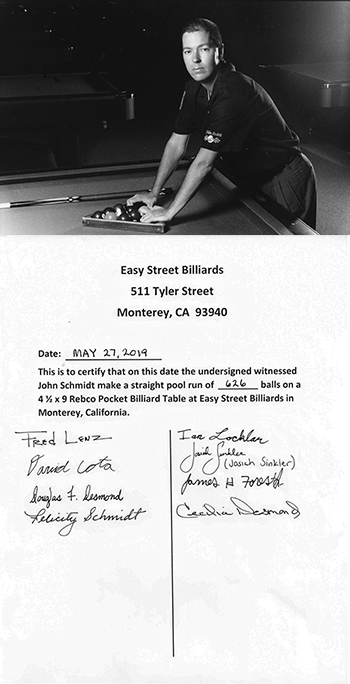
The Arizona trip proved to be a turning point for Team Schmidt. While Schmidt authored another personal best – 464 – and ran through five more 300-ball runs, it was information away from the table that helped him turn a corner.
“I learned a ton of important things in Phoenix,” Schmidt said.
For starters, Schmidt started to change habits, change playing strategies and even change his attire.
“I bought a pair of Hoka shoes,” he said. “[Fellow pro] Mike Davis told me about them. They made a huge difference. My feet and legs didn’t get nearly as tired. I also started eating differently. I started fasting and drinking these B-12 smoothies from Whole Foods. I started breaking the balls differently. I was improving every day by learning what worked and what didn’t.”
Just three weeks later, the Schmidts and Desmond were back in Monterey for Challenge IV, a previously scheduled one-month stint.
“We’d already had the fourth block scheduled, so this was happening regardless,” said Schmidt. “And, truthfully, this was going to be the last block. Doug had spent a lot of money to help us, and it was costing me a lot of money too.”
On the second of the 16 days Schmidt played in May he ran 421.
“That gave me high hopes,” Schmidt recalled. “Then I had about a 10-day lull of high 200s and low 300s.”
Perhaps the most astonishing factor in Schmidt’s four-block assault on Mosconi’s run was his perseverance and mental fortitude in the face of 200- and 300-ball “lulls.”
While every long run and new personal high were great achievements, they were, at the same time, failures.
“If I was at Derby City and ran 400 I would be the hero,” Schmidt offered. “I’d be carried off on everyone’s shoulders and I’d have eight people trying to take me out to a nice dinner. But in this environment, there is no fanfare when I mess up. I feel like an idiot and I have to start over. It’s the only time in my career where I’ve done things that I would normally think are great and I feel like the biggest loser on the planet.
“I had hundreds of days that just were not fun. People think a lot of pros can do this, but I want to see how they react after they get a skid at 390 or a miscue at 275, day after day. When you’re on a big run everyone is watching. They’re all off their phones and their jaws are hanging open. Then when you screw up everyone just walks away.
“It’s an awful thing when you miss,” he added. “The livestream in Phoenix was good because it forced me to just rack the balls and start over. There were times I just wanted to break my cue and walk out of the building. But I kept going because I thought at any moment I could reach greatness. There were times I ran a 330 and followed with 170 on the very next shot. That’s hard to do when you’re disgusted.”
The mental focus it takes to endure hours of shooting, days on end, also took a physical toll on Schmidt.
“Some days I would walk in and run 100 four times in a row,” said Schmidt. “Now it’s noon and I’m already worn out. I still have a half day left. Or I’d run 360 and it’s after 6 o’clock. I’ve run past dinner, but I keep playing. Then I get a skid. My whole body is messed up.
“In Phoenix there were a number of days where I’d walk in and run 360 on the first or second shot,” he said, laughing at the recollection. “Now my feet hurt, my neck hurts and we’ve just started. It’s streaming live and people are yelling, “Yeah! Let’s put on a show!’ Meanwhile, I’m dying.”
Still, by Challenge IV, Schmidt’s new routine was paying dividends. In the evenings, Felicity would make dinner while John and Desmond logged the days numbers and discussed strategy.
“We constantly tested things,” Schmidt said. “Sleeping more, sleeping less. Eating more, eating less. Breaking hard, breaking soft. Every day, Doug and I were throwing stuff at the wall to see what would stick. Doug is a good player and is very knowledgeable. He’d say, “Why don’t we hit the break softer tomorrow?’ Or, “Let’s use high left on the break ball.'”
Schmidt would watch the evening news and retire early. Schmidt would rise by 6 a.m. and have his morning cup of coffee with Desmond. On the way to Easy Street, they would stop at Whole Foods to grab a few egg croissants and some fruit. Once at the poolroom, they would vacuum the table, polish the balls, close the drapes and start the camera. It became a ritual.
It was late in the day a week into his final trip to Monterey when Schmidt found himself deep into what he thought might be a record run. He cleared 450. Next, he blazed past his previous record of 464. Suddenly, he was knocking on the door of 500.
At 490, Schmidt faced a break shot to the right of the rack. It was a relatively routine break shot for Schmidt.
“I dogged my brains out,” Schmidt said in disgust. “And I will admit that it was 110 percent because of the pressure. It was right in front of me and I thought, “This is it.’ And I completely fainted. I let everyone down…Doug, my dad, my wife, my family, my fans. It was more heat than I could handle.”
Not surprisingly, Schmidt took a day of rest following the 490.
“Listen, I’m 46,” Schmidt confided. “I tried to wrap my head around accepting that failure was more likely than success.”
Twelve days later, on Monday, May 27, Schmidt strolled into Easy Street for another day of attempts. Unofficially, he had eight more days with which to break the record.
He wouldn’t need them.
Schmidt limbered up with 126, then 28.
“It was a perfect start,” he recalled. “I was still fresh. I had good energy. The conditions were perfect.”
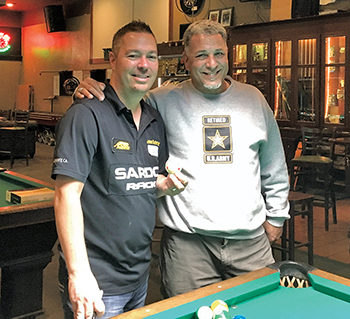
So were his patterns. He blazed through rack after rack. When he got to his break ball, Desmond would calmly grab their trusty Sardo Rack and corral the balls for the next rack. A few hours later, Schmidt was well into the 300s. Soon after, he had topped 450 and the pressure began to build.
“470 to 530 I was a nervous wreck,” Schmidt admitted.
Ironically, at 490, Schmidt was faced with the very same break shot he’d botched two weeks earlier. Schmidt glanced over at Desmond, but Desmond refused to make eye contact. Schmidt felt nauseous.
“It was miserable,” he said. “If there was a heart monitor, I could have lit up an entire city.”
This time, however, Schmidt did not “faint.” The 5 ball sailed smoothly into the corner pocket and the cue ball dove into the rack, creating a nice spread of balls.
“Well,” said Desmond, matter-of-factly. “Engert is handled.” Having cleared two significant hurdles, Schmidt knew the record was in sight.
Schmidt broke at 504 and worked his way through the rack. At 518, Schmidt made the break ball, but the cue ball found its way into the middle of the rack. He feared the worst. Would he end up tree-topped or trapped? The balls seemed to move in slow motion. At the last second, the balls opened up and Schmidt saw a lane. He had one shot, a missable ball along the rail. It forced him to elevate his cue.
Suddenly, the panic, fear and nerves all set in. To Schmidt, virtually every shot the rest of the way looked nearly impossible.
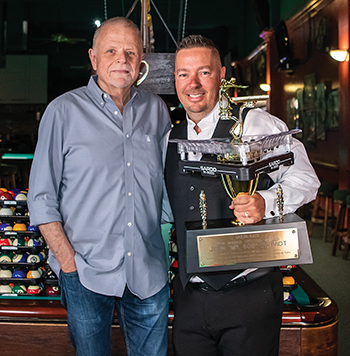
“My heart was going a million beats a second,” he insisted.
Having successfully dodged that bullet, Schmidt knew Mosconi’s elusive 526 was in this single rack. A few balls later, Schmidt opened up a small cluster of balls.
“You need four,” Desmond offered.
The balls were right in front of him for the taking. Strange thoughts started to creep into Schmidt’s mind. What if they’d miscounted? What if they moved the coin (used to count racks) wrong and he was really only at 512?
So after Schmidt returned from his bathroom break to pocket 526, there was no celebration. No jumping up and down. No hugging.
“I didn’t want to beat the record by two balls,” Schmidt rationalized. “I wanted to put up a number that might last as long as Willie’s did. I know how hard it is to run this many balls.”
Schmidt continued for another 100 balls, finally missing on a combination at 626. “It was a shot that I could have made, but it was very missable,” Schmidt said. “If the run had to end, that’s the way I wanted it.”
Not surprisingly, news of Schmidt’s run blew up pool’s corner of social media. The New York Times heralded the accomplishment and a local Monterey television station did a short piece with Schmidt. Fans and fellow pros offered their congratulations.
“It is my proudest moment,” acknowledged Schmidt, “and the fanfare and congratulations from my fans and peers was way more than I thought it would be.”
The news, however, also sparked debate over the merits and significance of Schmidt’s 626. Critics claimed Mosconi’s run, completed in an exhibition match, was made during “competition,” while Schmidt simply set up break shots to start his runs.
“The criticism and skepticism have bothered me, to be honest,” Schmidt said of the posts. I can’t believe some of the things people have said. To me, it’s a small-minded mentality. In the end, though, it’s been about one percent of the comments.”
It appears that the Billiard Congress of America, recognized keeper of the sport’s official rules and records, has found no fault with Schmidt’s run. In early June, Desmond flew to the BCA office in Colorado with the unedited videotape. BCA officials Rob Johnson and Shane Tyree watched the entire four-hour plus video, and while no official statement has been released, the BCA is expected to recognize Schmidt’s effort as a “record exhibition high run.” It is also expected that the run will be submitted to the Guinness Book of Records.
In the meanwhile, Schmidt has been huddling with friends and advisors to discuss the best ways to capitalize on the record. An edited (for time) version of the video has been prepared but has yet to be released.
“Honestly, I have no idea what I’m supposed to do with the video,” Schmidt confessed. “I’ve got to monetize this to a degree. I don’t really make money in pool. It is an opportunity for me and I can’t let that pass by. I’m not going to simply release this video for free and end up dying broke behind a Walgreens. If the world won’t allow me to get something from this video, then I guess the world will never see it.”
Schmidt contends that he has not shot an inning of straight pool since Memorial Day. “I really want to put together a nice run the next time I step to the table,” he said. “It’s ego and pride. It’s important to me to run 250 or 300. The inning after that I won’t care.”
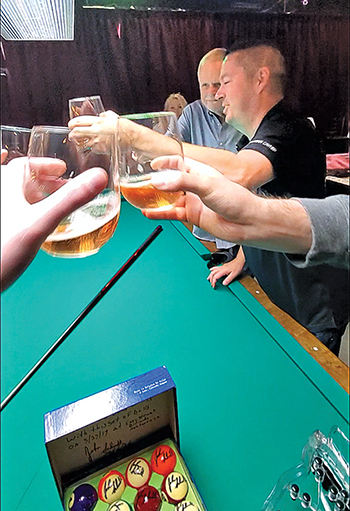
How Schmidt’s 626 will be remembered in pool lore remains to be seen. Will it carry the same mystique as Mosconi’s 526? Will it last as long?
Schmidt isn’t sure himself, but he is understandably proud of the effort and the result.
“I feel like this whole journey brought the pool world together a bit,” he said. “It was nice to see everyone talking pool and talking about straight pool again.”
WILSON ANNOUNCES FINAL SELECTIONS FOR TEAM USA
After making “some of the roughest telephone calls I’ve ever had to make,” Team USA captain Mark Wilson announced his five-man team for the 21st Mosconi Cup, scheduled for Dec. 1-4, in Blackpool, England. The squad features a mixture of veteran players and youth.
Not surprisingly, newly minted U.S. Open 9-Ball champion Shane Van Boening will lead the U.S. squad, which has dropped four Mosconi Cups in a row (and six of seven) to Team Europe. The 31-year-old Van Boening will play in his eighth Cup, and will be joined by Cup veterans Corey Deuel, also making his eighth appearance, and John Schmidt, who played in 2006 in Rotterdam. Making their Mosconi Cup debuts will be 27-year-old Justin Bergman of Fairview Heights, Ill., and 26-year-old Justin Hall of Palm Harbor, Fla.
The “tough calls” Wilson made were to Brandon Shuff, Oscar Dominguez and Jeremy Sossei, who have been offered coaching positions in Blackpool. Dominguez and Shuff have each participated in one Mosconi Cup, with Dominguez being a member of the last U.S. team to win the title, in 2009.
“This represents a new era for Team USA,” said Wilson, who was named captain by Matchroom Sport in January, just a month after Team USA was humiliated by Team Europe, 12-2, in Las Vegas. “And I’m counting on these players to be leaders. “The final decisions were difficult,” Wilson added. “Every player put a lot of time and effort into their game over the past nine months. And they all represented the sport and the U.S. well during that time. There were a few close calls, but I’m confident in these picks. It was a pretty thorough process.”
According to Wilson, the three players left off the final squad were asked to travel with the team to England, expense-paid, to assist during the event. “This won’t be a holiday,” Wilson added. “Each player will be assigned special duties, setting up little refresher drills for the team before each round.” Wilson said the duties include an Offensive Coordinator, a Defensive Coordinator (to work on safeties and kick shots) and Specialty Shots Coordinator (for breaking and elevated cue shots).
“I will have drills for the players to work on,” said Wilson, “and the coaches will help the players run through the drills.”
According to Wilson, the team will meet in St. Louis, Nov. 20-21, for intensive practice sessions at Lindenwood University, where Wilson coaches the billiards program. The team will participate in Mosconi Cup-style match play at Starship Billiards in Decatur, Ill., the following two days. After several more days of practice in St. Louis, the team will share a Thanksgiving dinner, before leaving for Blackpool on Friday, Nov. 28. “I feel great about Team USA,” Wilson said. “I’m ready to go to war with these guys.”
Wilson Names Team USA Hopefuls
 As was his original intent, Mosconi Cup Team USA Captain Mark Wilson worked quickly to select the players who will compete for the final five roster spots for the 2014 event in December in Blackpool, England. Wilson announced the selection of eight players who will train and compete together through the summer, before the captain whittles the list down to the five players who will wear the red, white and blue in Blackpool.
As was his original intent, Mosconi Cup Team USA Captain Mark Wilson worked quickly to select the players who will compete for the final five roster spots for the 2014 event in December in Blackpool, England. Wilson announced the selection of eight players who will train and compete together through the summer, before the captain whittles the list down to the five players who will wear the red, white and blue in Blackpool.
Not surprisingly, Wilson tabbed America’s No. 1, Shane Van Boening, and immediately announced that he will expect the taciturn star to provide leadership to the 2014 squad. “Shane sets a great example,” Wilson said in a press release. “And I expect to rely on him for leadership this year.”
Wilson also named seven-time Mosconi Cup veteran Corey Deuel, who many thought should have been on the team in 2013, to the squad. John Schmidt, Oscar Dominguez and Brandon Shuff, each of whom has participated in one Mosconi Cup, were named to the team was well. Leaning on America’s youth, Wilson rounded out his selection with Southern Classic One-Pocket champion Justin Bergman, Derby City titlist Justin Hall and Connecticut’s Jeremy Sossei.
“I’m really excited by this team,” Wilson said. “Every player seems so genuinely appreciative and excited. They’re all willing to do whatever it takes to develop a strong team and a strong sense of unity.”
More interesting than who Wilson selected, of course, was the list of players who weren’t invited to “camp.” The most notable omission was Johnny Archer, whose string of 17 consecutive Mosconi Cup appearances will come to an end. Fourteen-time Cup participant Earl Strickland and nine-time team member Rodney Morris were also left off the roster. In fact, Van Boening will be the only holdover from the 2013 squad that lost 21-1 to Team Europe in Las Vegas.
“I didn’t interview those players,” Wilson admitted. “And I explained to Johnny that I thought it best to go in a completely different direction this year. A lot of it is about attitude. Last year I felt there was no sense of urgency. There seemed to be a sense that it was a yearend bonus, and if the team won, great.”
Another player conspicuous by his absence is Mike Dechaine, one of the most consistent American players over the past three years.
“I spoke to Mike,” said Wilson. “In the end I felt that his reputation among the players wasn’t a good fit at this stage for a team event like the Mosconi Cup.”
Wilson added that his plan is to get the players together several times over the summer and fall for practice and team bonding. Wilson said he planned to make the final cut to five players after the U.S. Open, and that Team USA would meet and practice together for a week at Lindenwood University near St. Louis before departing for London. The dates of the 2014 Mosconi Cup are Dec. 1-4.
IPT Round Three: The Plot Thickens as the Field Thins
Round three starts today in the International Pool Tour’s North American Open and already 17,066 games have been played. Fatigue certainly played a role yesterday with 120 players facing a $5,000 difference in payout as they were whittled down to 60 in 12 straight hours of 8-ball action. The 60 remaining contenders who advanced to round three have been placed into 12 groups of five players each. Three players from each group will advance to the next round. The 24 who are eliminated will receive a lovely parting gift of $10,000.
Here’s a breakdown of yesterday’s highlights:
Mike Sigel was eliminated with a 2-3 record after losses to Marlon Manalo, Marko Lohtander and Quinten Hann. “The Mouth” settled for 61st and a $5,000 consolation prize.
The female players are near extinction, survived only by Sarah Ellerby who edged out Corey Harper by less than one percentage point in win average to advance to round three. Both Loree Jon Jones and Allison Fisher went winless in round two, and Gerda Hofstatter was eliminated with only one win.
Only eight players went undefeated throughout yesterday’s round, including three Americans: David Matlock, Nick Varner, and Charlie Williams. Also unscathed: Australian Quinten Hann, Filipino Santos Sambajon, Mexican Rafael Martinez, Mika Immonen of Finland, and Ivica Putnik of Croatia.
The Filipino contingent is now down three men, with Warren Kiamco and Gandy Valle eliminated after round two, and Jose Parica eliminated after round one. Still, 10 of the original 13 remain and most dominated their groups. Francisco Bustamante fell to Efren Reyes, but has the highest winning percentage of the entire field at 73.68 percent. (Johnny Archer is second with 70 percent.)
Snooker superstar Ronnie O’Sullivan held on by the skin of his teeth, with only two wins, but advanced on the merit of his winning percentage. On the other hand, Takeshi Okumura missed out on advancing by 0.03 percent to Larry Nevel.
Veterans Allen Hopkins, Kim Davenport, Keith McCready are all heading home. George San Souci and Tony Chohan went winless in round two. Other notables who are heading home with $5,000 consolation prizes: Danny Basavich, Jeremy Jones, George Breedlove and Oliver Ortmann.
Round three is upon us, and each player will play five matches among formidable fields. Here’s a quick analysis:
Ellerby will have to face two top Americans: Gabe Owen and Charlie Williams and two Filipinos: Marlon Manolo and Ronato Alcano. Good luck!
Earl Strickland is alive and well in the tournament, but grouped with Raj Hundal and Efren Reyes, the recently inducted Hall-of-Famer will have to fight hard to see another day.
German Thorsten Hohmann is by far the biggest name in his group, but will face Mick Hill, a promising British 8-baller.
Check out this group: Break-and-run Bustamante, Undefeated Ozzy Quinten Hann, 8-Ball Boy Wonder Karl Boyes, Prince of Pool Cory Deuel, and Bad Boy O’Sullivan. Yikes!
Mika Immonen and John Schmidt will face off in their group — undoubtedly there will be some good-looking pool played there.
IPT Open Kicks Off: U.K. Sizzles, U.S. Stumbles, Qualifiers Thrive
The overwhelming success of shooters from the United Kingdom and several strong qualifiers are the big surprises from the first day of the history-making IPT North American 8-ball Open, now underway at the Venetian in Las Vegas.
Meanwhile, conventional-wisdom favorites such as Jose Parica, Mike Davis, Max Eberle, and Tony Robles were headed back to the drawing board, or at least a practice table, to ponder their early exits from the $2 million tournament.
But the biggest shocker was how incredibly well the contingent from the U.K. performed. Compatriots on the English 8-ball circuit (and relative unknowns elsewhere) Michael Hill, Darren Appleton and Carl Morris each went a perfect 4-0 in the first round of round-robin play, which featured 20 groups of five players each.
The second 100 competitors in the 200-player field will wage war today in their first-round matches. The top three players in each of the 40 groups advance to the next round; the eliminated players settle for a modest $2,000 each.
Here’s a brief wrap-up of the first day’s highlights:
• Of the 100 competitors in play Sunday, 13 finished with perfect 4-0 records, representing a wide array of nations: Michael Hill, Darren Appleton and Carl Morris of the U.K.; Americans Dennis Hatch, Steve Moore, Marco Marquez, and John Schmidt; Hungary’s Vilmos Foldes; Ralf Souquet of Germany; Canadian Luc Salvas; Nick Van den Berg of the Netherlands; Filipino Antonio Lining; and Mexico’s Rafael Martinez.
Incredibly, Martinez, Moore and Marquez were among the 50 qualifiers for the event, beyond the 150 regular IPT members. And Foldes earned his spot in the event as Buddy Hall’s replacement, after the Hall-of-Famer bowed out of the Open.
• Some folks have to go, and there were several flame-outs from well-regarded American players: Robles (U.S.), 1-3; 2006 Derby City Classic Master of the Table winner Jason Miller (U.S.), 1-3; Max Eberle (U.S.), 1-3; Robb Saez (U.S.), 1-3; Tony Crosby (U.S.), 0-4; and Tommy Kennedy (U.S.), 2-2.
Filipinos are expected to perform well at the Open, but expatriate Parica struggled to a 1-3 record and an early exit.
• Snooker superstar and 8-ball neophyte Ronnie O’Sullivan (U.K.) squeaked into the next round with a 2-2 record.
• After losing his first two matches, Shawn “Bubba the Love Sponge” Putnam (U.S.) gutted out two victories to advance.
• Long-ago road player Michael Zimmerman (U.S.) emerged to win his group — a toughie that included Filipino Warren Kiamco and Keith McCready of the U.S. It was not clear initially whether McCready or Kiamco would advance, since both held 2-2 records and an identical games-won percentage.
Hohmann Takes World 14.1 Straight Pool Top Honor
The German penchant for straight pool was evident in the final of the World 14.1 Straight Pool Championship, in which Thorsten Hohmann defeated his fellow countryman Thomas Engert, 200-80.
The first tournament of its kind in over 15 years, the World 14.1 Straight Pool Championship took place over six days, from May 30 to June 4 at the Hilton in East Brunswick, N.J., attracting an international field of 64 players.
Hohmann topped the list of high runs with 174, and tore through the bracket in the double-elimination second round and single-elimination final. In the first round, a round-robin format among eight groups of eight players, Hohmann survived the elimination of half the field with a record of five wins and two losses, to John Schmidt and Allen Hopkins, respectively.
In the second round, among 32 players, Hohmann remained on the winners’ side with wins over Antonio Fazanes, 150-68, and Charlie Williams, 150-14. With only the top 16 advancing to the third and final round, Hohmann defeated everyone in his path. He avenged his first loss to Schmidt with a 200-64 win, then went on to beat Austrian “Ice Princess” Jasmin Ouschan, 200-117, and came out on top of a tight match against Max Eberle, 200-177 to land in the final with Engert.
Engert had a tough road to the finals, losing to Allen Hopkins in the second round, but making it into the top 16 with a win over Vilmos Foldes, 150-45, on the one-loss side. In the final round, he matched up against some formidable straight pool opponents, including Bobby Hunter, who he barely bested, 200-177, straight-pool veteran Allen Hopkins, 200-32, and Mika Immonen, 200-80.
The all-German final saw Hohmann ahead for the entire match, jumping out to a 160-49 lead. Engert was able to narrow the gap to 80, but missed the 15 in the side pocket after leaving the cue ball burrowed into a stack of balls. Hohmann ran out the next two racks for the win.
Thirty-two Remain in the World 14.1 Straight Pool Championship
The World 14.1 Straight Pool Championship got underway May 30 at the Hilton in East Brunswick, N.J., the first competition of its kind in over 15 years.
The 64-player field included some of pool’s elite players, including Mika Immonen, Nick Varner, Mike Sigel, Allen Hopkins, and Oliver Ortmann. Top women pros Jeanette Lee, Jasmin Ouschan and Megan Minnerich were also invited to play.
The event kicked off with an opening ceremony in which the players were divided into eight groups of eight players. The first round was a round-robin format, with only the top 32 advancing to round two, which is currently underway, employing a double-elimination format.
After round one, Max Eberle, Go Takami and Mike Sigel remained undefeated. Lee, losing only to Sigel, had a 6-1 record going into round two. Big names eliminated early include Johnny Archer, Larry Schwartz, Luc Salvas, Tony Robles, Jimmy Mataya, Varner and Minerich.
Players recording high runs thus far include: Mike Sigel – 125, Ralf Souquet – 99, John Schmidt – 91, Danny Harriman – 83 and Thorsten Hohman – 71.
Up-And-Comers Make Their Mark in Las Vegas
Day two of the Enjoypool.com 9-Ball Championship was full of excitement at the Riviera Hotel and Casino in Las Vegas, Nev.
In what many fans are calling the best match they’ve ever witnessed, Efren “The Magician” Reyes would not succumb to a 10-1 deficit to Allen Hopkins, who was playing near flawless pool. In the case match, Hopkins jarred the 8-ball, allowing Reyes back to the table. This would prove a fatal mistake, as Reyes strung together a 10-game comeback to win the match 11-10.
Also on the men’s side, Taipei’s Po Cheng Kuo knocked crowd favorite Tony Robles to the one-loss side, 11-8. Kuo will next face Johnny Archer who scored an 11-0 win over John Schmidt on Monday.
The women’s side had its share of excitement as well, as Arizona’s Angel Paglia upset Karen Corr, ranked second in the Women’s Professional Billiard Association, with a 9-7 win.
Another non-WPBA player, Jasmin Ouschan, scored a hill-hill win over former World Champion Ga-Young Kim. Ouschan went on to score a 9-2 win over Alice Rim later on Monday. Chinese up-and-comer Xiao-Ting Pan continued to make waves with her impressive play, scoring a 9-6 win over Jeanette Lee.
U.S. Open Update!
But many favorites are still undefeated after two rounds, including Efren Reyes and John Schmidt (who play each other today), as well as former U.S. Open Champs Johnny Archer and Francisco Bustamante and defending champ Gabe Owen.
Korea International Championships, Day One
The Dragon Promotions event being held in Korea has finished a day of competition. Of the top pros in attendance, only American Mike Davis has been eliminated, defeated by Japanese player Goh Takami and then ousted by German Thorsten Hohmann.
Noteworthy players who have made it to the final 16 include Rodney Morris, Max Eberle, John Schmidt (who ran six consecutive racks against one opponent in an earlier round), young Korean player Seung-woo Ryu, Mika Immonen, Johnny Archer, and Charlie Bryant.
Many top pros who don’t often travel to Asia took this event as an opportunity to extend their trip to this area of the globe following the World Pool Championships in Taiwan last week.

